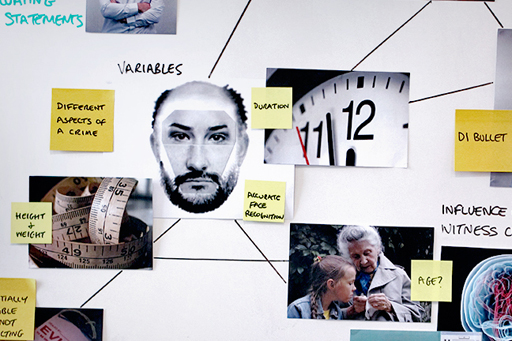1 Remembering different aspects of a crime

As a witness to a crime, there are many factors that can work to our disadvantage. The experience of viewing a crime can be very brief – perhaps even a matter of a few seconds – and we may not even realise that a criminal event is taking place until it is over.
Effective observation
Reliable evidence depends upon the witness being able to observe effectively. For example, accurate face recognition is dependent upon seeing the perpetrator’s face for a sufficiently long period of time (e.g. Ellis et al., 1977). Furthermore, the crime may take place in poor lighting and at some distance away. Research demonstrates that beyond a certain distance, and depending on the light, identification may be problematic. Researchers tested participants’ ability to recognise a target’s face at seven distances and nine illumination levels. Immediately after seeing the target face, participants were asked to identify the face they had just seen from an array of photographs (Wagenaar and Van Der Schrier, 1996). As a result, the following guideline emerged regarding what observation conditions are needed for identification evidence to be sufficiently accurate (known as the ‘Rule of 15’):
- the maximum distance is 15 meters from the event
- the minimum illumination is 15 lux.
Lux is a measurement of luminance, where 0.3 lux is equivalent to night time with a full moon; 30 lux is equivalent to a badly lit room; and 300 lux is equivalent to a brightly lit room. It is important to note that this research does not mean that identification will be accurate if the perpetrator was seen from less than 15 metres and at more than 15 lux, just that identification evidence cannot be relied on unless these requirements are met.
This study demonstrates that although estimator variables are not under the control of the police/criminal justice system, research can still investigate their influence and provide useful advice – in this instance, by providing information relating to the feasibility of an accurate identification.
What about other judgements that witnesses might be asked to make?
Estimates of time and distance
Research suggests that, generally, we are not very accurate in our estimates of how long something lasts (temporal duration) or of distance. We may overestimate the length of events of short duration, sometimes by as much as 500%. Many studies (e.g. Block, 1978) have shown that a time interval containing unfamiliar, less predictable, complex or many components (as when solving a complex puzzle) is estimated to be significantly longer than an interval of the same duration that contains more familiar, more predictable, simpler or fewer components (as when doing simple arithmetic).
Estimate of date
Our ability to provide the correct date for an event may also be poor. Research testing participants’ ability to date episodes they had personally experienced showed that accuracy in dating was dependent on how long ago the episode occurred (known as the retention interval), and that accuracy decreased rapidly as the retention interval lengthened. When asked about experiences that had taken place in the previous week, participants tended to date accurately 85–90% of the time. For experiences that occurred over three months ago, however, accurate dating dropped to 15–20% (Thompson et al., 1996).
Furthermore, many studies have reported a phenomenon known as ‘forward telescoping’, a tendency to assign a date to an event that is more recent than the actual date of occurrence. This tendency has been observed as soon as eight weeks after the event occurred. Telescoping is thought to arise because we overestimate the frequency of events occurring during a certain time period, and therefore mistakenly import or bring forward events that actually happened earlier.
Estimating height and weight
Our estimates of people’s height and weight are also frequently inaccurate. Researchers asked 588 participants to estimate the height and weight of 1 of 14 males who had previously asked them for directions in a busy city centre (Flin and Shepherd, 1986). They found errors for height judgements to range from an underestimation of 14 inches (35.56 centimetres) to an overestimation of 8 inches (20.32 centimeters). Judgements of weight ranged from an underestimation of 98 lbs (44.45 kilograms) to an overestimation of 36 lb (16.33 kilograms). The results showed that the height of all 14 males was underestimated by 6 inches (15.24 centimetres) by at least one participant.
Generally, these findings indicated a ‘trend of underestimating above-average characteristics and overestimating below-average characteristics … indicating a general regression to the population mean’ (Flin and Shepherd, 1986, p. 35). Their results also indicated that the participant’s own height and weight was used as a norm or anchor against which the height or weight of the male was estimated (although this effect was small in female participants’ judgements about height, and absent in their judgements about weight). Therefore, when asking witnesses to estimate such characteristics, it may be helpful to obtain relative judgements. For example, if a perpetrator is seen standing in a doorway, their height may be judged by asking how much shorter than the door the perpetrator was.
